As(III) Removal via Combined Addition of Mg- and Ca-Based Adsorbents and Comparison to As(V) Removal via Those Mechanisms
Abstract
1. Introduction
2. Materials and Methods
2.1. Mg- and Ca-Based Adsorbents
2.2. As(III) Removal Tests Using Mg- and Ca-Based Adsorbents
2.2.1. Preparation of Synthetic As(III)-Contaminated Water
2.2.2. Experiment Procedure
2.3. Experimental Reproducibility
2.4. Preparation of Samples for X-Ray Diffraction (XRD) Analysis
- (a)
- Sample mixed with equal amounts of unused MgCO3 and CaO;
- (b)
- Sample mixed with equal amounts of unused MgCO3 and Ca(OH)2;
- (c)
- Solid sample collected after adding MgCO3 and CaO (each 0.4 g/L) to deionized water;
- (d)
- Solid sample collected after adding MgCO3 and Ca(OH)2 (each 0.4 g/L) to deionized water;
- (e)
- Solid sample collected after adding MgCO3 and CaO (each 0.4 g/L) to the As(III) solution (CAS0 = 10 mg/L and pH0 = 7);
- (f)
- Solid sample collected after adding MgCO3 and Ca(OH)2 (each 0.4 g/L) to the As(III) solution (CAS0 = 10 mg/L and pH0 = 7);
- (g)
- Solid sample collected after adding MgCO3 and CaO (each 0.4 g/L) to the As(V) solution (CAS0 = 10 mg/L and pH0 = 7);
- (h)
- Solid sample collected after adding MgCO3 and Ca(OH)2 (each 0.4 g/L) to the As(V) solution (CAS0 = 10 mg/L and pH0 = 7).
2.5. Confirmation Tests for As Removal by Generated Mg(OH)2 and CaCO3
2.5.1. Mg(NO3)2-Addition Tests with Alkaline As Solutions
2.5.2. Ca(NO3)2- and Na2CO3-Addition Tests with Alkaline As Solutions
3. Results
3.1. As-Removal Ratio
3.1.1. As-Removal Ratio for Single Addition of One Type of Adsorbent
3.1.2. As-Removal Ratio for Combined Addition of Two Types of Adsorbents
3.2. Mg- and Ca-Residual Ratios
3.2.1. Mg- and Ca-Residual Ratios for Single Addition of One Type of Adsorbent
3.2.2. Mg- and Ca-Residual Ratios for Combined Addition of Two Types of Adsorbents
3.3. pH of Treated Water
3.3.1. pH of Treated Water for Single Addition of One Type of Adsorbent
3.3.2. pH of Treated Water for Combined Addition of Two Types of Adsorbents
3.4. XRD Patterns for MgCO3 + CaO, and MgCO3 + Ca(OH)2
3.5. Results of Mg(NO3)2-Addition Tests with Alkaline As Solutions
3.6. Results of Ca(NO3)2- and Na2CO3-Addition Tests with Alkaline As Solutions
4. Discussion
4.1. Effects of Combined Addition
4.1.1. Effects of Combined Addition on As-Removal Performance
4.1.2. Effects of Combined Addition on Mg- and Ca-Leaching Behaviors
4.2. As-Removal Mechanisms in the Combined Additions of MgCO3 + CaO and MgCO3 + Ca(OH)2
4.2.1. Incorporation of As into the Generated Precipitates of Mg(OH)2 + CaCO3
4.2.2. Incorporation of As into the Generated Precipitate of Mg(OH)2
4.2.3. Incorporation of As into the Generated Precipitate of CaCO3
4.3. Comprehensive Evaluation
5. Conclusions
Author Contributions
Funding
Institutional Review Board Statement
Informed Consent Statement
Data Availability Statement
Acknowledgments
Conflicts of Interest
References
- Kobya, M.; Soltani, R.D.C.; Omwene, P.I.; Khataee, A. A review on decontamination of arsenic-contained water by electrocoagulation: Reactor configurations and operating cost along with removal mechanisms. Environ. Technol. Innov. 2020, 17, 100519. [Google Scholar] [CrossRef]
- Abiye, T.A.; Bhattavharya, P. Arsenic concentration in groundwater Archetypal study from South Africa. Groundw. Sustain. Dev. 2019, 9, 100246. [Google Scholar] [CrossRef]
- Rahman, M.M.; Ng, J.C.; Naidu, R. Chronic exposure of arsenic via drinking water and its adverse health impacts on humans. Environ. Geochem. Health 2009, 31, 189–200. [Google Scholar] [CrossRef] [PubMed]
- The World Health Organization (WHO). Arsenic. In Guidelines for Drinking-Water Quality, 4th ed.; The World Health Organization: Tarxien, Malta, 2011; pp. 315–318. ISBN 9789241548151. Available online: https://apps.who.int/iris/bitstream/handle/10665/44584/9789241548151_eng.pdf (accessed on 3 December 2024).
- Ministry of the Environment, Government of Japan. Environmental Quality Standards for Human Health. Available online: https://www.env.go.jp/en/water/wq/wp.pdf (accessed on 7 January 2025).
- Ministry of the Environment, Government of Japan. National Effluent Standards. Available online: https://www.env.go.jp/en/water/wq/nes.html (accessed on 7 January 2025).
- Jadhav, S.V.; Bringas, E.; Yadav, G.D.; Rathod, V.K.; Ortiz, I.; Marathe, K.V. Arsenic and fluoride contaminated groundwaters: A review of current technologies for contaminants removal. J. Environ. Manag. 2015, 162, 306–325. [Google Scholar] [CrossRef]
- Sarkar, A.; Paul, B. The global menace of arsenic and its conventional remediation-A critical review. Chemosphere 2016, 158, 37–49. [Google Scholar] [CrossRef] [PubMed]
- Ghosh, S.; Debsarkar, A.; Dutta, A. Technology alter-natives for decontamination of arsenic-rich groundwater—A critical review. Environ. Technol. Innov. 2019, 13, 277–303. [Google Scholar] [CrossRef]
- Kumar, R.; Patel, M.; Singh, P.; Bundschuh, J.; Pittman, C.U., Jr.; Trakal, L.; Mohan, D. Emerging technologies for arsenic removal from drinking water in rural and peri-urban areas: Methods, experience from, and options for Latin America. Sci. Total Environ. 2019, 694, 133427. [Google Scholar] [CrossRef] [PubMed]
- Chuc, P.N.; Bac, N.Q.; Thao, D.T.P.; Kien, N.T.; Chi, N.T.H.; Noi, N.V.; Nguyen, V.T.; Bich, N.T.H.; Nhiem, D.N.; Khieu, D.Q. Highly efficient adsorption of arsenite from aqueous by zirconia modified activated carbon. Environ. Eng. Res. 2024, 29, 230076. [Google Scholar] [CrossRef]
- Yadegari, M.; Panahi, H.A.; Rahmati, S.H.; Mohammadi, A.; Imani, F. Poly(allyl alcohol-co-vinyl acetate)-grafted concrete waste for adsorptive removal of As(III). Mater. Chem. Phys. 2024, 326, 129826. [Google Scholar] [CrossRef]
- Choudhury, T.R.; Sajib, M.S.H.; Sowrav, S.F.F.; Khan, S.R.; Alam, M.N.E.; Amin, M.N. Nanostructured bi-metallic biochar: An innovative approach for arsenic (III) removal from contaminated water. Environ. Chem. Ecotoxicol. 2025, 7, 10–18. [Google Scholar] [CrossRef]
- Park, Y.Y.; Tran, T.; Lee, Y.H.; Nam, Y.I., II; Senanayake, G.; Kim, M.J. Selective removal of arsenic(V) from a molybdate plant liquor by precipitation of magnesium arsenate. Hydrometallurgy 2010, 104, 290–297. [Google Scholar] [CrossRef]
- Tresintsi, S.; Simeonidis, K.; Katsikini, M.; Paloura, E.C.; Bantsis, G.; Mitrakas, M. A novel approach for arsenic adsorbents regeneration using MgO. J. Hazard. Mater. 2014, 265, 217–225. [Google Scholar] [CrossRef]
- Yu, X.Y.; Luo, T.; Jia, Y.; Zhang, Y.X.; Liu, J.H.; Huang, X.J. Porous hierarchically micro-/nanostructured MgO: Morphology control and their excellent performance in As(III) and As(V) removal. J. Phys. Chem. C 2011, 115, 22242–22250. [Google Scholar] [CrossRef]
- Opiso, E.M.; Sato, T.; Morimoto, K.; Asai, A.; Anraku, S.; Numako, C.; Yoneda, T. Incorporation of arsenic during the formation of Mg-bearing minerals at alkaline condition. Miner. Eng. 2010, 23, 230–237. [Google Scholar] [CrossRef]
- Camacho, J.; Wee, H.Y.; Kramer, T.A.; Autenrieth, R. Arsenic stabilization on water treatment residuals by calcium addition. J. Hazard. Mater. 2009, 165, 599–603. [Google Scholar] [CrossRef]
- Montes-Hernandez, G.; Concha-Lozano, N.; Renard, F.; Quirico, E. Removal of oxyanions from synthetic wastewater via carbonation process of calcium hydroxide: Applied and fundamental aspects. J. Hazard. Mater. 2009, 166, 788–795. [Google Scholar] [CrossRef] [PubMed]
- Olyaie, E.; Banejad, H.; Afkhami, A.; Rahmani, A.; Khodaveisi, J. Development of a cost-effective technique to remove the arsenic contamination from aqueous solutions by calcium peroxide nanoparticles. Sep. Purif. Technol. 2012, 95, 10–15. [Google Scholar] [CrossRef]
- Hu, C.-Y.; Lo, S.-L.; Kuan, W.-H. High concentration of arsenate removal by electrocoagulation with calcium. Sep. Purif. Technol. 2014, 126, 7–14. [Google Scholar] [CrossRef]
- Sugita, H.; Oguma, T.; Hara, J.; Zhang, M.; Kawabe, Y. Removal of arsenate from contaminated water via combined addition of magnesium-based and calcium-based adsorbent. Sustainability 2023, 15, 4689. [Google Scholar] [CrossRef]
- Lin, Q.; Chen, W.; Lin, F.; Zhu, H.; Wang, X. Exaggerated arsenic removal efficiency and pH adaptability by adsorption using monodispersed porous pinecone-like magnesium hydroxide. AQUA 2023, 72, 969–982. [Google Scholar] [CrossRef]
- Lee, J.-U.; Jeong, Y.; Lee, Y.-J.; Lee, C.-G.; Park, S.-J. Harnessing wood bottom ash for efficient arsenic removal from wastewater: Adsorption mechanisms and process optimization. Chemosphere 2024, 364, 143204. [Google Scholar] [CrossRef] [PubMed]
- Sugita, H.; Morimoto, K.; Saito, T.; Hara, J. Effects of soils on environmental stability of spent Mg-based and Ca-based adsorbents containing arsenite. Sustainability 2024, 15, 4008. [Google Scholar] [CrossRef]
- Zhang, S.; Li, H.; Wu, Z.; Post, J.E.; Lanson, B.; Liu, Y.; Hu, B.; Wang, M.; Zhang, L.; Hong, M.; et al. Effects of cobalt doping on the reactivity of hausmannite for As(III) oxidation and As(V) adsorption. J. Environ. Sci. 2022, 122, 217–226. [Google Scholar] [CrossRef] [PubMed]
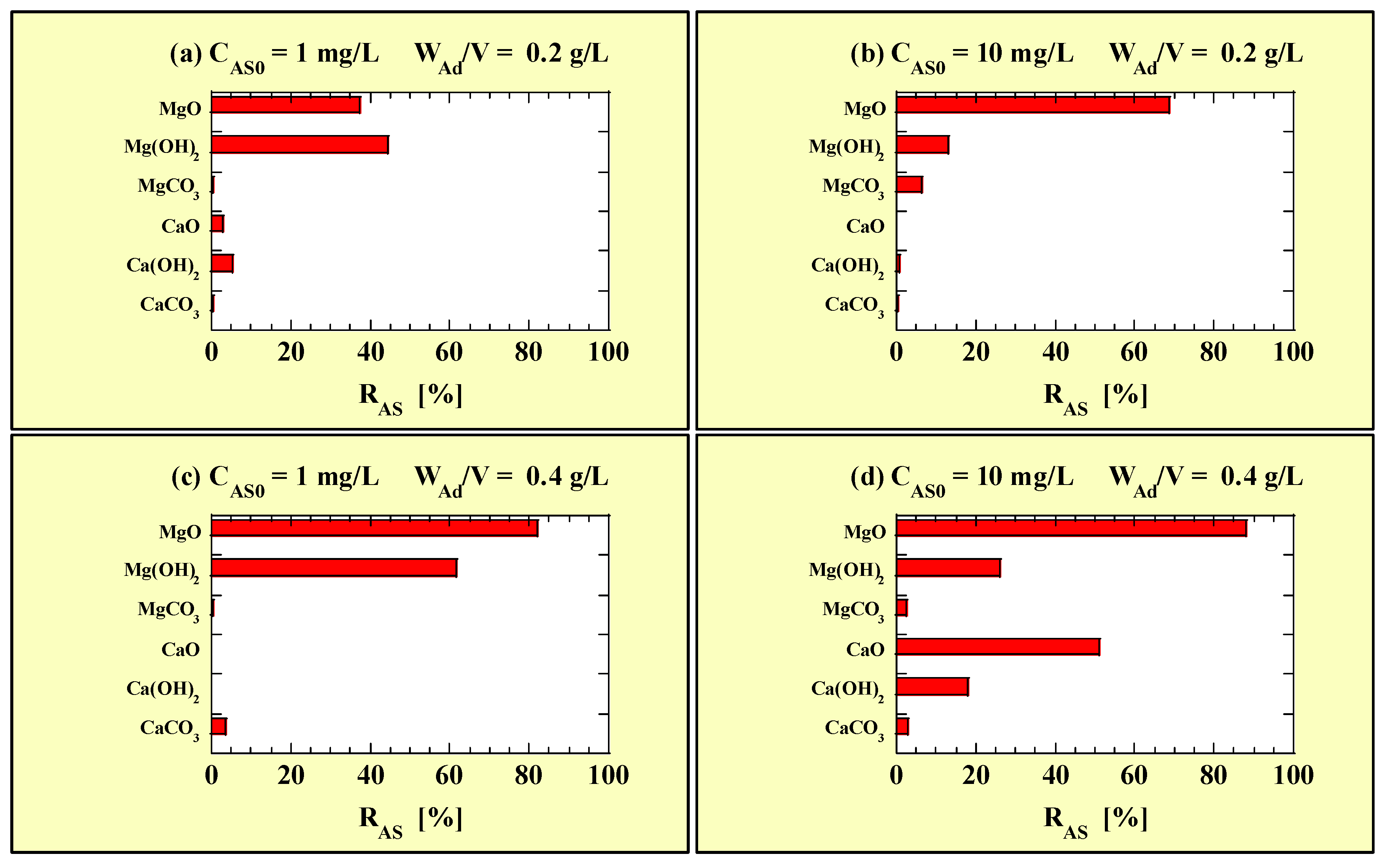
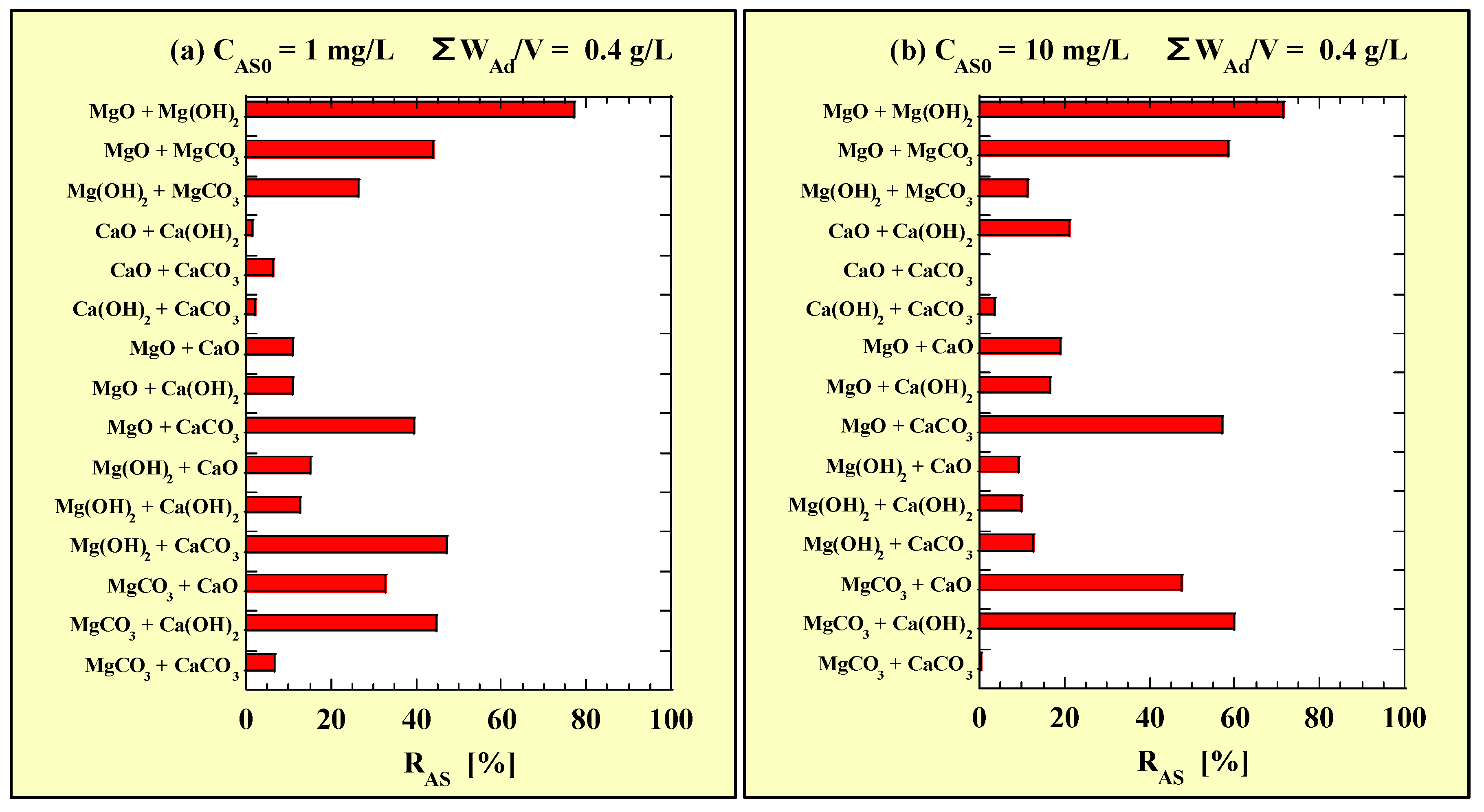
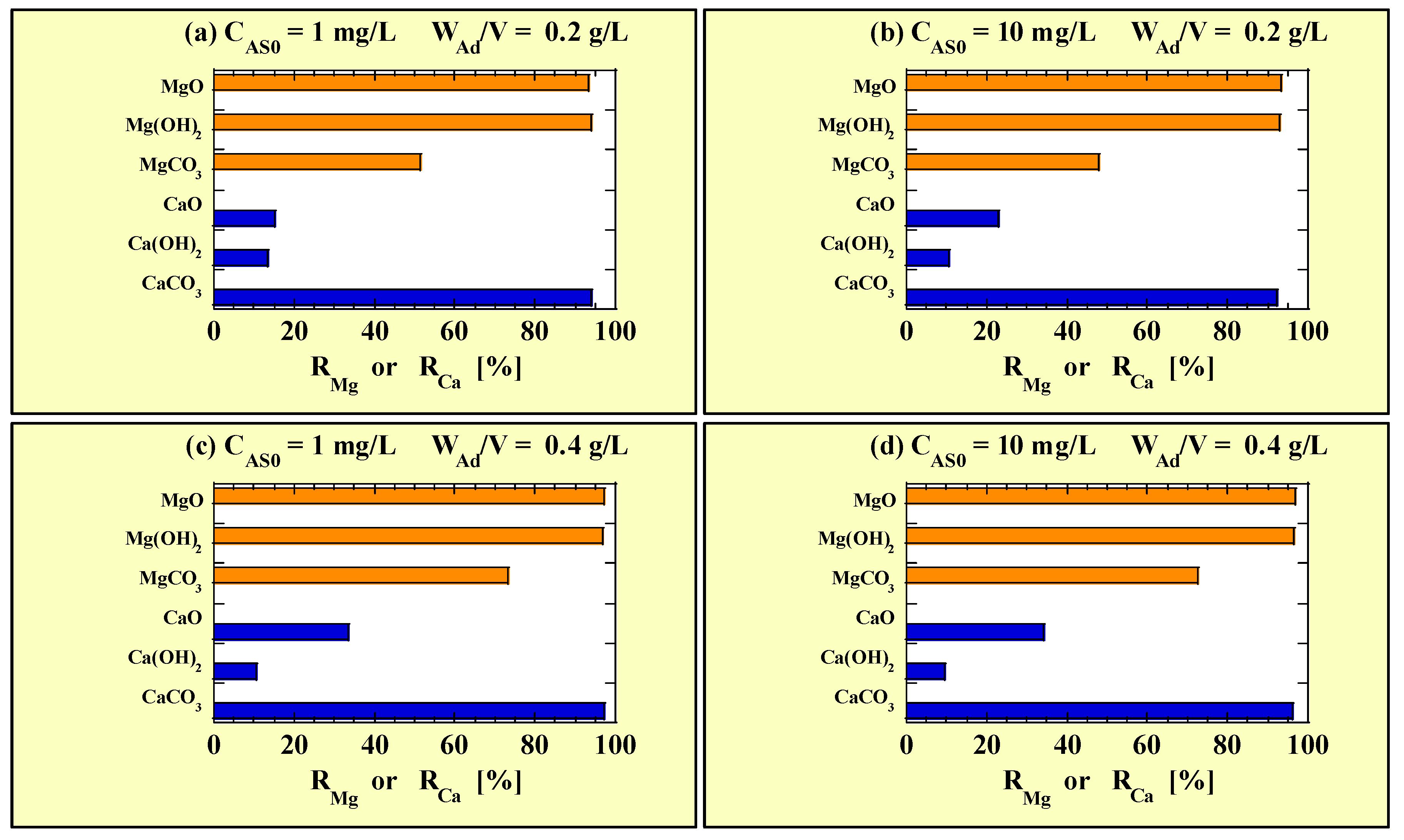
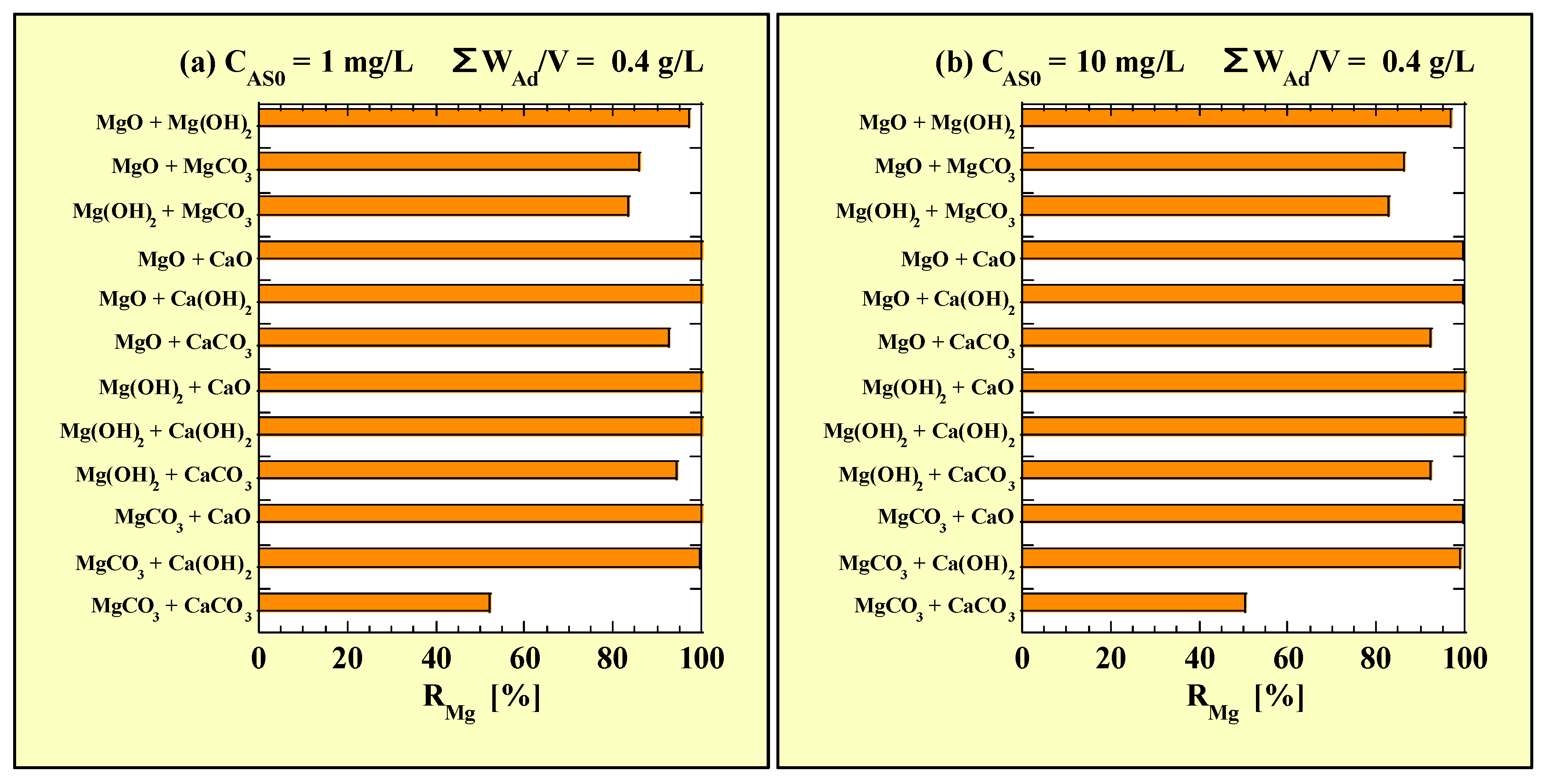
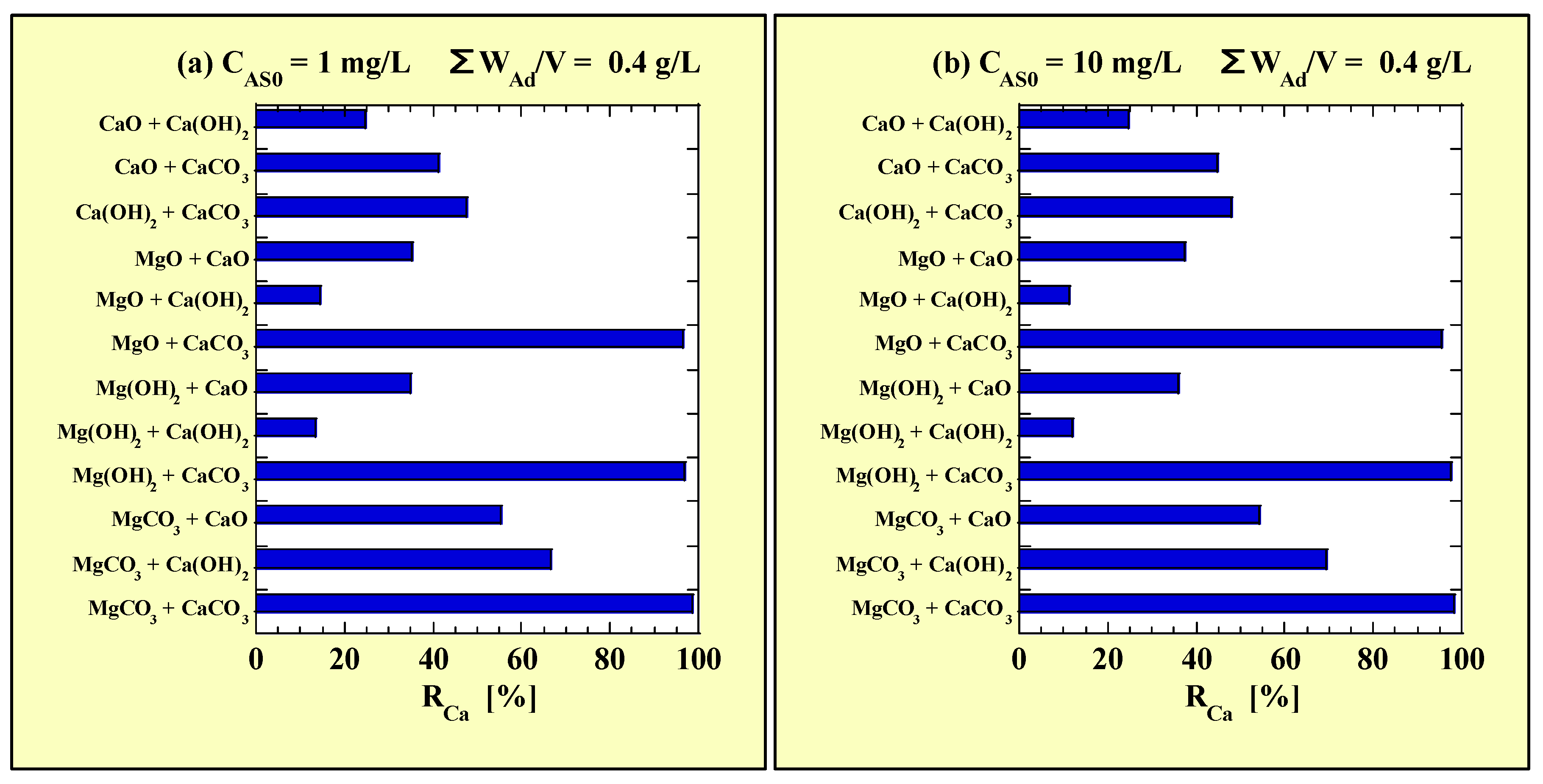


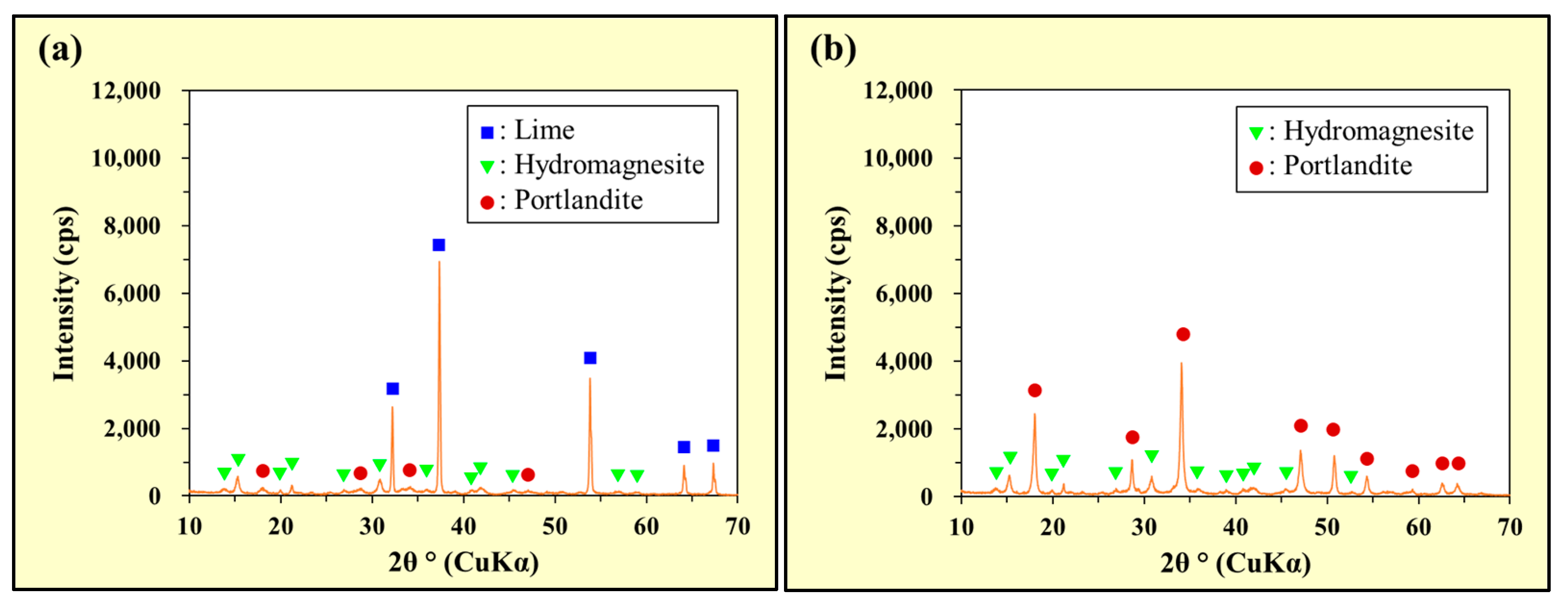
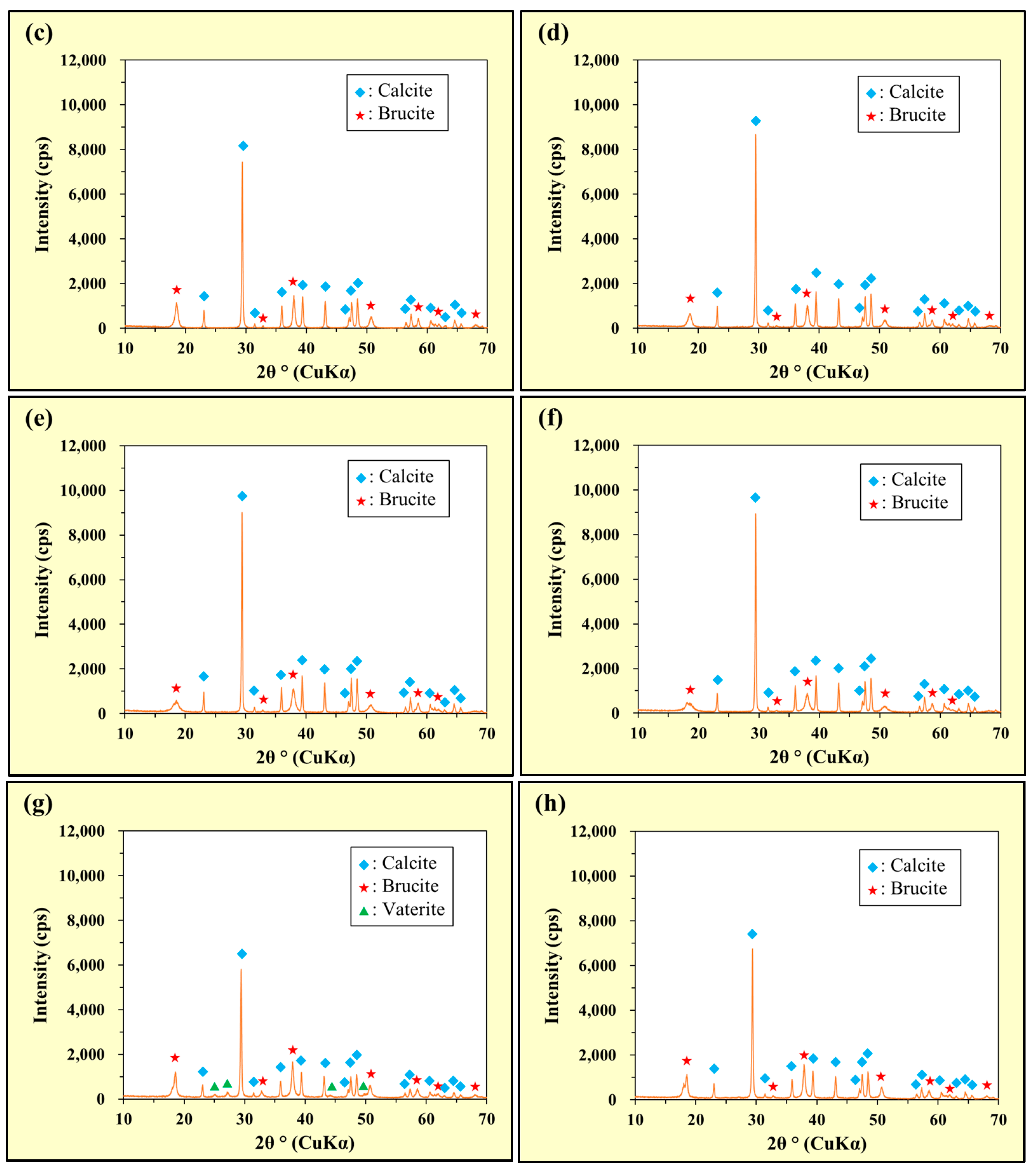

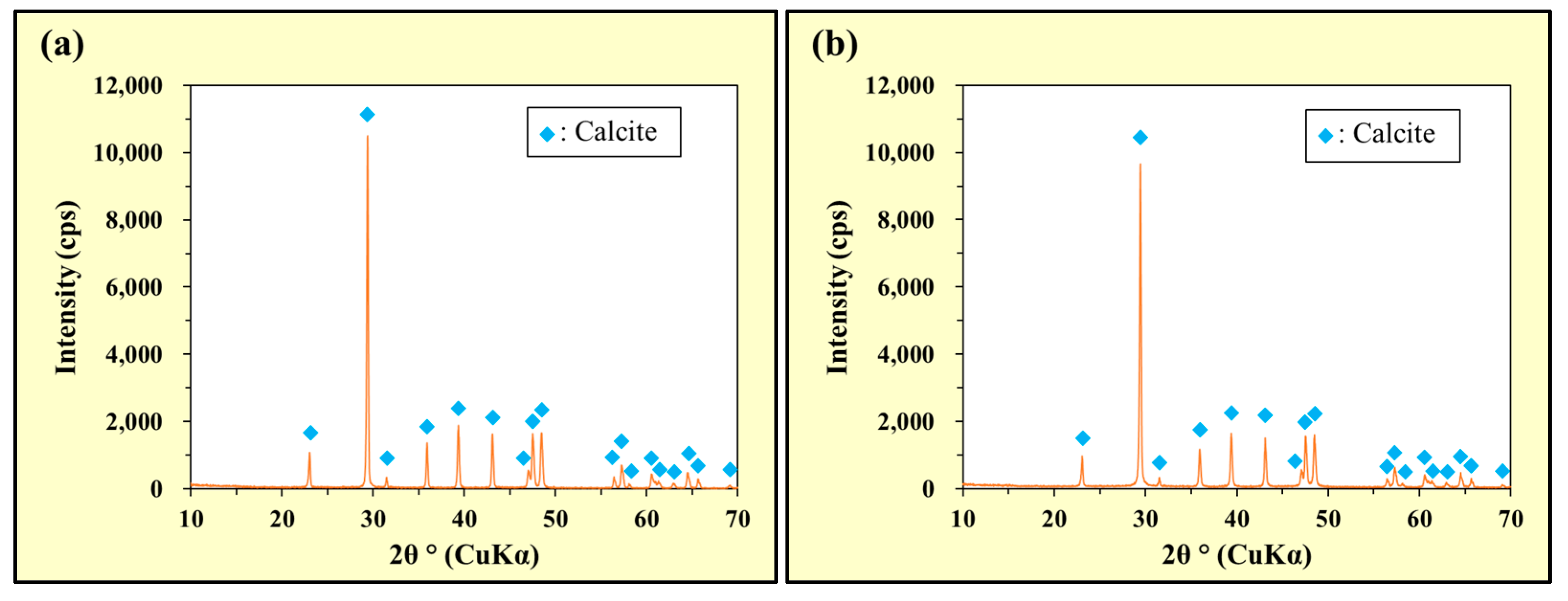

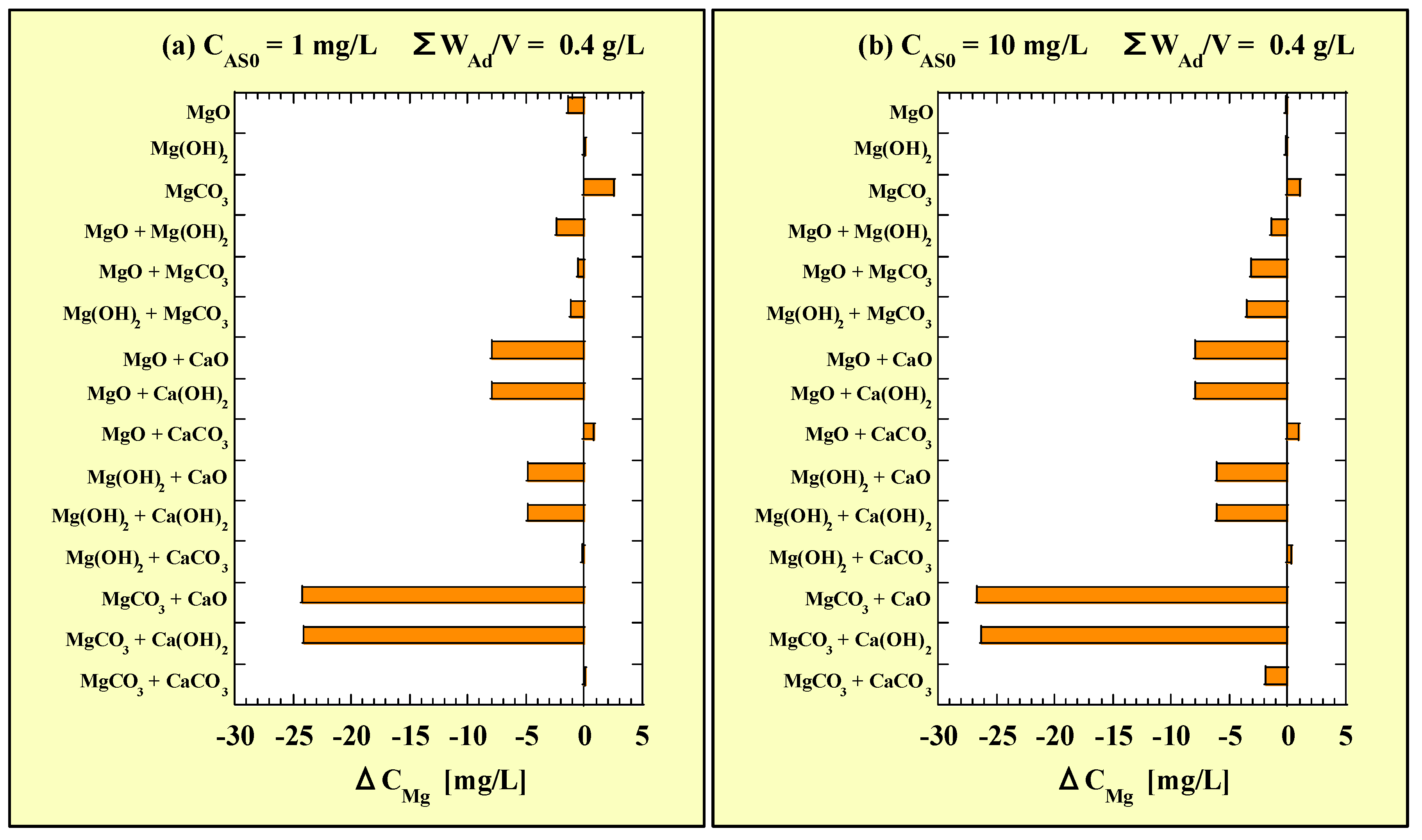

| Adsorbent | Dp50 (μm) | SBET (m2/g) | αMg (%) | αCa (%) | P (%) |
|---|---|---|---|---|---|
| MgO | 1.54 | 4.3 | 59.1 | - | 98.0 |
| Mg(OH)2 | 4.13 | 22.0 | 40.6 | - | 97.3 |
| MgCO3 | 15.0 | 26.0 | 24.8 | - | 86.1 |
| CaO | 19.6 | 2.7 | - | 71.2 | 99.6 |
| Ca(OH)2 | 41.7 | 14.3 | - | 53.5 | 98.9 |
| CaCO3 | 15.4 | 0.8 | - | 39.7 | 99.1 |
| Adsorbent | WAd/V (g/L) | CAS (mg/L) | CMg (mg/L) | CCa (mg/L) | pHf |
|---|---|---|---|---|---|
| MgO | 0.203 ± 0.001 | 0.632 ± 0.065 | 8.07 ± 0.71 | - | 10.84 ± 0.03 |
| Mg(OH)2 | 0.201 ± 0.001 | 0.561 ± 0.025 | 4.84 ± 0.05 | - | 10.47 ± 0.01 |
| MgCO3 | 0.201 ± 0.001 | 1.001 ± 0.003 | 24.3 ± 0.0 | - | 10.64 ± 0.00 |
| CaO | 0.207 ± 0.002 | 0.980 ± 0.009 | - | 125 ± 0 | 11.77 ± 0.00 |
| Ca(OH)2 | 0.200 ± 0.000 | 0.955 ± 0.014 | - | 92.8 ± 1.1 | 11.72 ± 0.01 |
| CaCO3 | 0.204 ± 0.002 | 1.003 ± 0.003 | - | 4.87 ± 0.01 | 9.64 ± 0.05 |
| Experiment Type | As Valence Tested in This Study |
|---|---|
| As-removal tests using Mg- and Ca-based adsorbents | As(III) |
| Samples prepared for XRD analysis | As(III), As(V) |
| Mg(NO3)2-addition tests with alkaline As solutions | As(III), As(V) |
| Ca(NO3)2- and Na2CO3-addition tests with alkaline As solutions | As(III), As(V) |
| CAS0 | 1 mg/L | 1 mg/L | 10 mg/L | 10 mg/L | ||||
|---|---|---|---|---|---|---|---|---|
| WAd/V | 0.2 g/L | 0.4 g/L | 0.2 g/L | 0.4 g/L | ||||
| CAS0 | CAS | CAS0 | CAS | CAS0 | CAS | CAS0 | CAS | |
| MgO | 1.01 | 0.632 | 1.07 | 0.193 | 10.8 | 3.36 | 10.7 | 1.28 |
| Mg(OH)2 | 1.01 | 0.561 | 1.06 | 0.406 | 10.8 | 9.35 | 10.7 | 7.95 |
| MgCO3 | 1.01 | 1.00 | 1.05 | 1.04 | 10.8 | 10.1 | 10.6 | 10.3 |
| CaO | 1.01 | 0.980 | 1.07 | 1.07 | 10.8 | 10.8 | 10.7 | 5.25 |
| Ca(OH)2 | 1.01 | 0.955 | 1.07 | 1.07 | 10.8 | 10.7 | 10.7 | 8.81 |
| CaCO3 | 1.01 | 1.00 | 1.05 | 1.01 | 10.8 | 10.8 | 10.6 | 10.2 |
| Combination | MgO | Mg(OH)2 | MgCO3 | CaO | Ca(OH)2 | CaCO3 |
|---|---|---|---|---|---|---|
| MgO | - | 0.244 | 0.618 | 0.954 | 0.953 | 0.672 |
| Mg(OH)2 | 0.244 | - | 0.814 | 0.911 | 0.937 | 0.585 |
| MgCO3 | 0.618 | 0.814 | - | 0.744 | 0.613 | 1.03 |
| CaO | 0.954 | 0.911 | 0.744 | - | 1.06 | 1.04 |
| Ca(OH)2 | 0.953 | 0.937 | 0.613 | 1.06 | - | 1.09 |
| CaCO3 | 0.672 | 0.585 | 1.03 | 1.04 | 1.09 | - |
| Combination | MgO | Mg(OH)2 | MgCO3 | CaO | Ca(OH)2 | CaCO3 |
|---|---|---|---|---|---|---|
| MgO | - | 3.06 | 4.48 | 8.67 | 8.98 | 4.66 |
| Mg(OH)2 | 3.06 | - | 9.58 | 9.74 | 9.69 | 9.44 |
| MgCO3 | 4.48 | 9.58 | - | 5.68 | 4.33 | 10.8 |
| CaO | 8.67 | 9.74 | 5.68 | - | 8.48 | 10.8 |
| Ca(OH)2 | 8.98 | 9.69 | 4.33 | 8.48 | - | 10.4 |
| CaCO3 | 4.66 | 9.44 | 10.8 | 10.8 | 10.4 | - |
| CAS0 | 1 mg/L | 1 mg/L | 10 mg/L | 10 mg/L | ||||
|---|---|---|---|---|---|---|---|---|
| WAd/V | 0.2 g/L | 0.4 g/L | 0.2 g/L | 0.4 g/L | ||||
| CMg | CCa | CMg | CCa | CMg | CCa | CMg | CCa | |
| MgO | 8.07 | - | 6.71 | - | 8.24 | - | 8.07 | - |
| Mg(OH)2 | 4.84 | - | 4.91 | - | 6.07 | - | 5.94 | - |
| MgCO3 | 24.3 | - | 26.9 | - | 26.9 | - | 27.9 | - |
| CaO | - | 125 | - | 195 | - | 112 | - | 189 |
| Ca(OH)2 | - | 92.8 | - | 197 | - | 99.1 | - | 198 |
| CaCO3 | - | 4.87 | - | 4.64 | - | 6.41 | - | 6.37 |
| CAS0 | Combination | MgO | Mg(OH)2 | MgCO3 | CaO | Ca(OH)2 | CaCO3 |
|---|---|---|---|---|---|---|---|
| 1 mg/L | MgO | - | 5.73 | 23.7 | 0.10 | 0.13 | 8.87 |
| Mg(OH)2 | 5.73 | - | 23.1 | 0.04 | 0.04 | 4.68 | |
| MgCO3 | 23.7 | 23.1 | - | 0.07 | 0.21 | 24.3 | |
| 10 mg/L | MgO | - | 6.80 | 23.8 | 0.29 | 0.29 | 9.12 |
| Mg(OH)2 | 6.80 | - | 23.4 | 0.04 | 0.03 | 6.34 | |
| MgCO3 | 23.8 | 23.4 | - | 0.14 | 0.52 | 25.0 |
| CAS0 | Combination | MgO | Mg(OH)2 | MgCO3 | CaO | Ca(OH)2 | CaCO3 |
|---|---|---|---|---|---|---|---|
| 1 mg/L | CaO | 97.0 | 93.6 | 64.2 | - | 193 | 134 |
| Ca(OH)2 | 94.3 | 94.4 | 37.5 | 193 | - | 102 | |
| CaCO3 | 2.97 | 2.55 | 1.12 | 134 | 102 | - | |
| 10 mg/L | CaO | 91.2 | 93.9 | 70.1 | - | 193 | 128 |
| Ca(OH)2 | 97.8 | 97.0 | 34.5 | 193 | - | 103 | |
| CaCO3 | 3.67 | 2.13 | 1.44 | 128 | 103 | - |
| No. | As Valence | WMgCO3/V (g/L) | WCaO/V (g/L) | WCa(OH)2/V (g/L) | pH0 | pHf | CAS0 (mg/L) | CAS (mg/L) | CMg (mg/L) | CCa (mg/L) | RAS (%) |
|---|---|---|---|---|---|---|---|---|---|---|---|
| (e) | As(III) | 0.404 | 0.402 | - | 7.43 | 11.91 | 10.51 | 4.43 | 0.04 | 116 | 57.8 |
| (f) | As(III) | 0.403 | - | 0.404 | 7.43 | 11.57 | 10.51 | 2.87 | 0.17 | 49.1 | 72.7 |
| (g) | As(V) | 0.404 | 0.402 | - | 7.47 | 11.87 | 10.04 | 0.350 | 0.10 | 120 | 96.5 |
| (h) | As(V) | 0.403 | - | 0.400 | 7.47 | 11.55 | 10.04 | 0.208 | 0.39 | 52.6 | 97.9 |
| As Valence | WMg(NO3)2/V (g/L) | pH0 | pHf | CAS0 (mg/L) | CAS (mg/L) | CMg (mg/L) | RAS (%) |
|---|---|---|---|---|---|---|---|
| As(III) | 4.01 | 11.99 | 9.82 | 10.06 | 0.489 | 251 | 95.1 |
| As(V) | 4.01 | 11.98 | 9.93 | 10.04 | 0.080 | 225 | 99.2 |
| As Valence | WCa(NO3)2/V (g/L) | WNa2CO3/V (g/L) | pH0 | pHf | CAS0 (mg/L) | CAS (mg/L) | CCa (mg/L) | RAS (%) |
|---|---|---|---|---|---|---|---|---|
| As(III) | 2.70 | 1.21 | 11.99 | 11.94 | 10.06 | 10.01 | 251 | 0.3 |
| As(V) | 2.71 | 1.21 | 11.98 | 11.88 | 10.04 | 1.12 | 225 | 88.9 |
| No. | As Valence | Combination | RMg (%) | RCa (%) | WR-Mg(OH)2/V(g/L) | WR-CaCO3/V (g/L) | QAS (mg/g) |
|---|---|---|---|---|---|---|---|
| (e) | As(III) | MgCO3 + CaO | 100 | 59.3 | 0.240 | 0.714 | 6.37 |
| (f) | As(III) | MgCO3 + Ca(OH)2 | 99.8 | 77.3 | 0.239 | 0.539 | 9.82 |
| (g) | As(V) | MgCO3 + CaO | 99.9 | 58.0 | 0.240 | 0.714 | 10.2 |
| (h) | As(V) | MgCO3 + Ca(OH)2 | 99.6 | 75.4 | 0.239 | 0.533 | 12.7 |
| As Valence | RMg (%) | WR-Mg(OH)2/V (g/L) | QAS (mg/g) |
|---|---|---|---|
| As(III) | 34.0 | 0.310 | 30.9 |
| As(V) | 40.7 | 0.371 | 26.8 |
| As Valence | RCa (%) | WR-CaCO3/V (g/L) | QAS (mg/g) |
|---|---|---|---|
| As(III) | 99.7 | 1.14 | 0.04 |
| As(V) | 99.6 | 1.14 | 7.81 |
Disclaimer/Publisher’s Note: The statements, opinions and data contained in all publications are solely those of the individual author(s) and contributor(s) and not of MDPI and/or the editor(s). MDPI and/or the editor(s) disclaim responsibility for any injury to people or property resulting from any ideas, methods, instructions or products referred to in the content. |
© 2025 by the authors. Licensee MDPI, Basel, Switzerland. This article is an open access article distributed under the terms and conditions of the Creative Commons Attribution (CC BY) license (https://creativecommons.org/licenses/by/4.0/).
Share and Cite
Sugita, H.; Morimoto, K.; Saito, T.; Hara, J. As(III) Removal via Combined Addition of Mg- and Ca-Based Adsorbents and Comparison to As(V) Removal via Those Mechanisms. Sustainability 2025, 17, 757. https://doi.org/10.3390/su17020757
Sugita H, Morimoto K, Saito T, Hara J. As(III) Removal via Combined Addition of Mg- and Ca-Based Adsorbents and Comparison to As(V) Removal via Those Mechanisms. Sustainability. 2025; 17(2):757. https://doi.org/10.3390/su17020757
Chicago/Turabian StyleSugita, Hajime, Kazuya Morimoto, Takeshi Saito, and Junko Hara. 2025. "As(III) Removal via Combined Addition of Mg- and Ca-Based Adsorbents and Comparison to As(V) Removal via Those Mechanisms" Sustainability 17, no. 2: 757. https://doi.org/10.3390/su17020757
APA StyleSugita, H., Morimoto, K., Saito, T., & Hara, J. (2025). As(III) Removal via Combined Addition of Mg- and Ca-Based Adsorbents and Comparison to As(V) Removal via Those Mechanisms. Sustainability, 17(2), 757. https://doi.org/10.3390/su17020757






